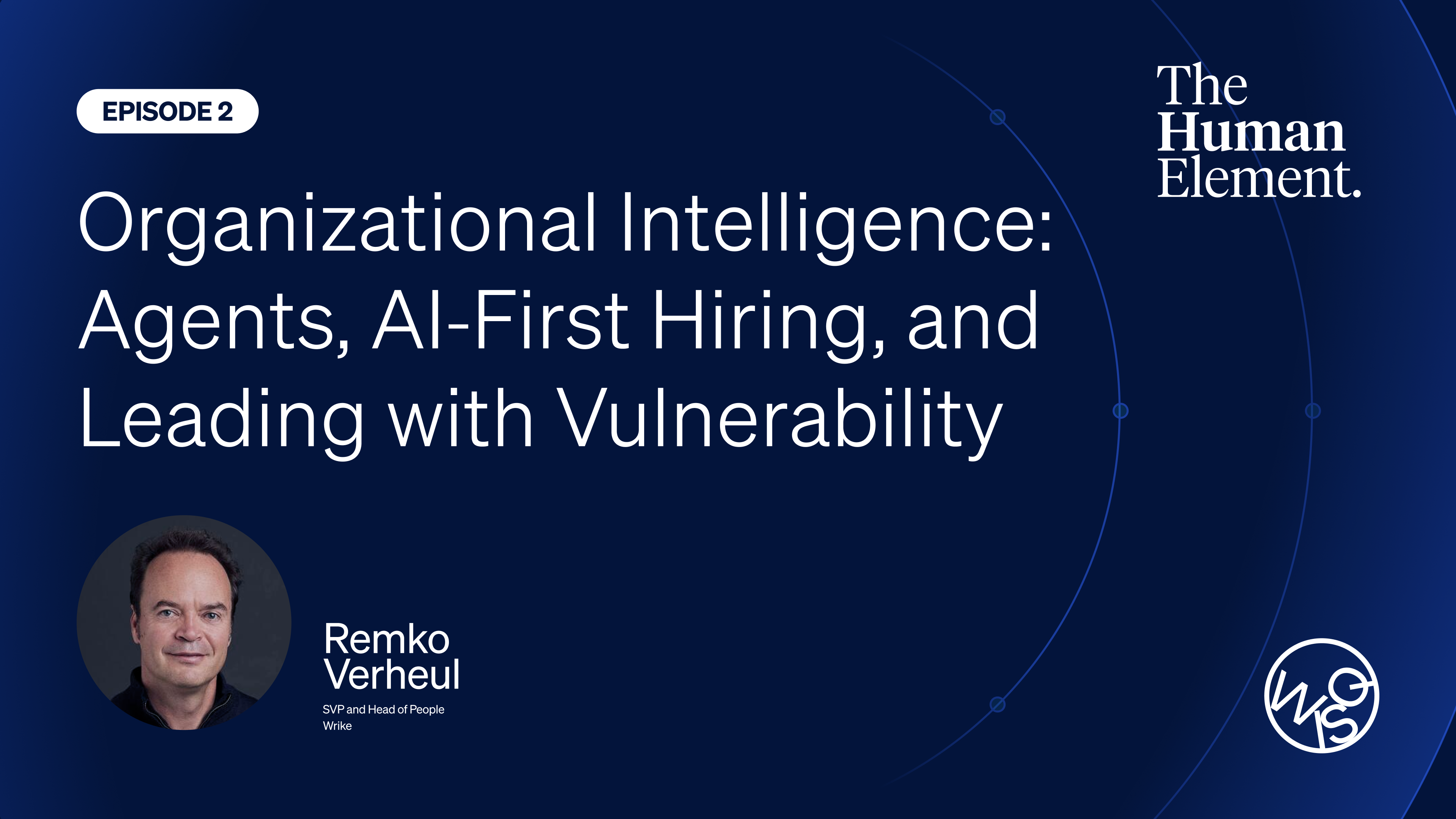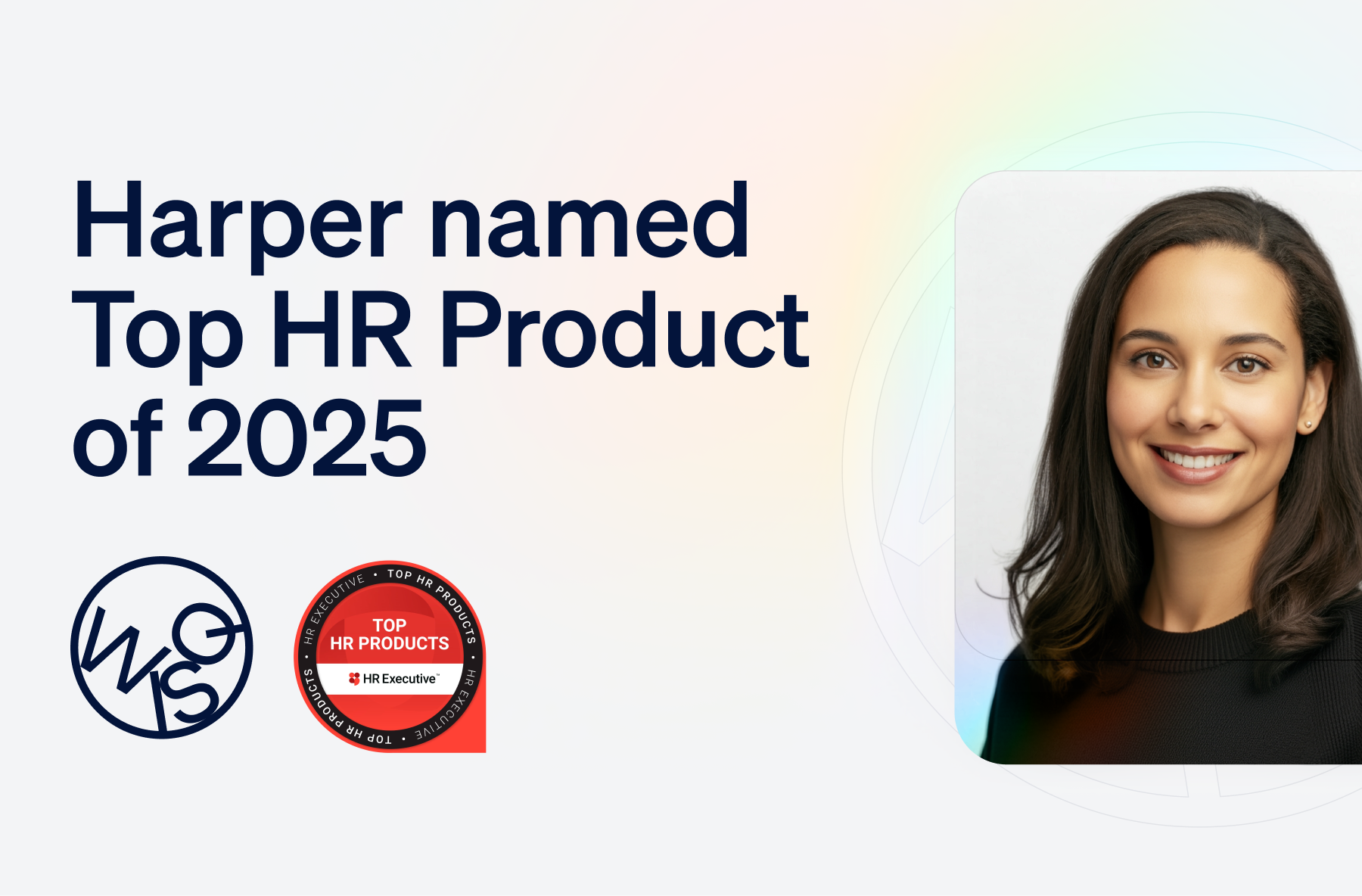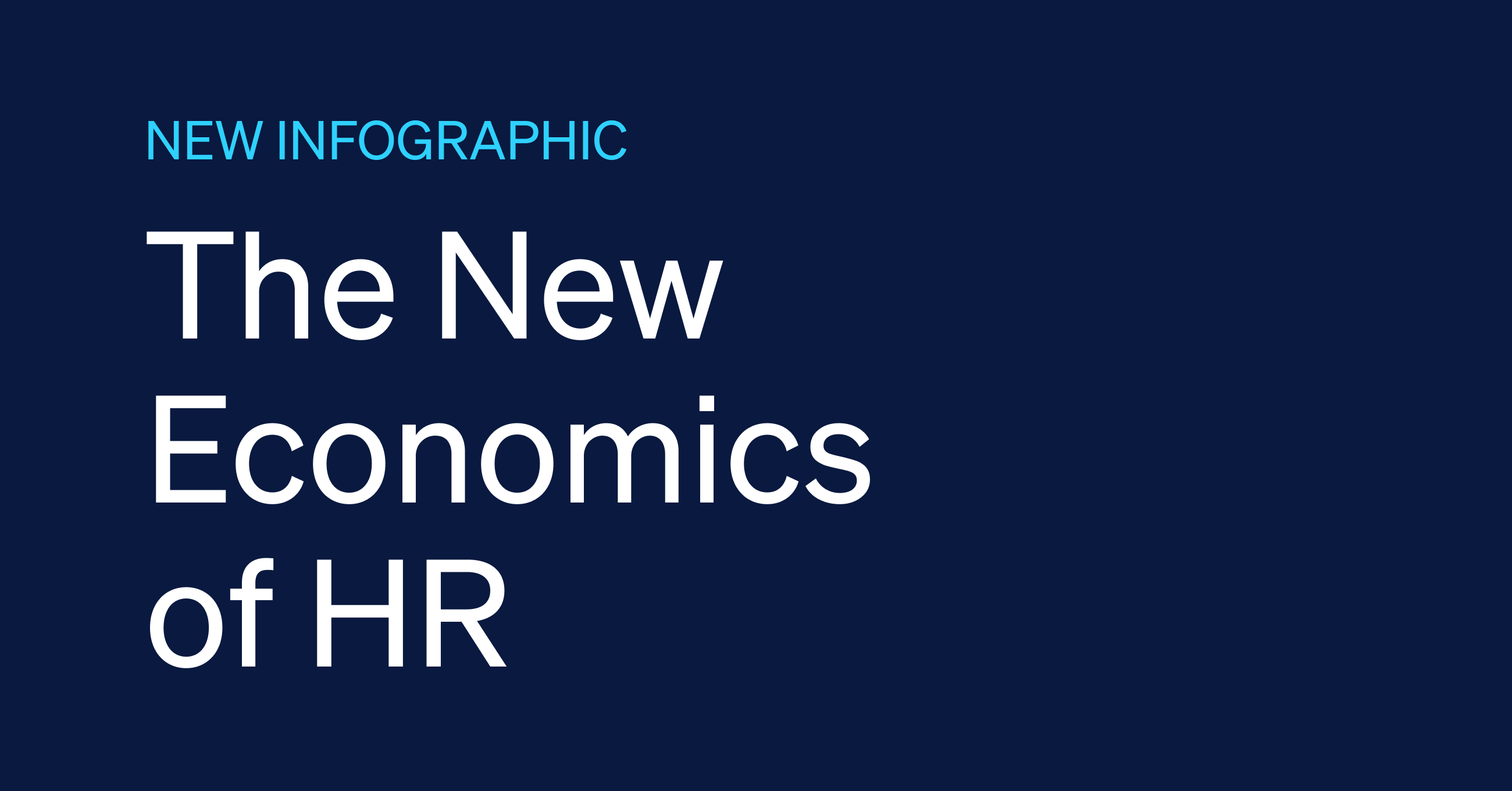The Human Element
The Human Element Episode 2: Agents, AI‑First Hiring, and Leading with Vulnerability
Wrike’s Head of People, Remko Verheul, joins The Human Element to share how human intelligence plus AI drives organizational intelligence and real business value.

How do you move beyond AI pilots to real business value?
In this episode of The Human Element, Remko Verheul, SVP and Head of People at Wrike, shares a practical blueprint for creating organizational intelligence: human intelligence plus AI. He explains how Wrike connects every workflow—product, go-to-market, and finance—then layers agentic capabilities on top, including a secure MCP protocol server that lets teams connect language models to live work data.
Inside HR, Remko walks through real use cases such as automated interview note-taking that maps to competencies and flags bias risks with human oversight. He outlines Wrike’s dual adoption model—top-down direction plus bottom-up experimentation—why leaders must be visible and vulnerable about what they don’t know, and how to hire for an AI-first mindset.
He closes with advice for candidates (lead with curiosity and use LLMs to critique your own work) and a strategy tip for executives: pressure-test every plan with AI from multiple stakeholder personas before you take it to the board.
Show Notes
Guest: Remko Verheul, SVP & Head of People at Wrike
Host: Barb Bidan, host of The Human Element
Key Takeaways
- Adopt the HI + AI = OI frame: combine human empathy and judgment with machine intelligence to build organizational intelligence.
- Build agentic workflows by connecting LLMs to trusted, structured work data through secure protocols.
- Pair top-down direction with bottom-up experimentation; add governance to keep efforts aligned.
- Modernize hiring with AI: automate interview note-taking and competency mapping while keeping human review for fairness.
- Recruit for an AI-first mindset—screen for curiosity, prompt literacy, and examples of AI-augmented work.
- Pressure-test decisions: run proposals through AI and ask for CFO- or CEO-style feedback to strengthen strategy.
Key Timestamps
[00:00] – Guest intro: Remko Verheul, SVP & Head of People at Wrike
[00:39] – Human + AI = Organizational Intelligence: amplification over replacement
[02:32] – Inside Wrike: agentic workflows, MCP server, and connecting LLMs to work data
[04:33] – HR use cases: AI-driven interview notes, competency scoring, and bias reduction
[05:58] – Top-down meets bottom-up: building agents with clear direction and governance
[06:39] – Leader playbook: be visible and vulnerable about AI’s unknowns
[08:02] – AI-first hiring and asking “where’s the AI?” in every plan and proposal
[14:52] – Zoom in/zoom out: pressure-testing strategies with models and stakeholder personas
Transcription
Barb Bidan:
Welcome to The Human Element, presented by Wisq. I’m your host, Barb Bidan, and in each episode, I sit down with CHROs and senior HR leaders to explore how AI innovation and human insight are reshaping the future of HR. We’ll explore how technology is reshaping leadership strategy and the role of HR by sharing candid stories, practical ideas, and strategic perspectives to help you shape the future.
The Human Element is brought to you by Wisq, the leader in agentic HR and creator of Harper, the world’s first AI HR Generalist. Learn how Harper can resolve up to 80 percent of routine HR tasks autonomously at wisq.com.
Today I have Remko Verheul with me. Remko is the Senior Vice President and Head of People at Wrike. He brings over twenty-five years of global HR leadership experience and is known for guiding high-growth, high-impact brands through cultural transformation and integrations and for building high-performing teams. Along the way, he’s focused on people-first growth and aligning employee experience, workforce strategy, and organizational change as key levers for scaling performance.
I’m looking forward to speaking with you today, Remko. Thanks for being here.
Remko Verheul:
Thanks for the invite, Barb. I’m looking forward to the conversation.
Barb Bidan:
I’m very much looking forward to hearing how Wrike is thinking about AI, especially given your background with the platform. How are you thinking about the idea of framing “human intelligence plus AI equals organizational intelligence”?
Remko Verheul:
For me, that concept is a guiding principle for how we drive value in the organization. It’s about organizing work through a platform that combines human insight and empathy with AI capabilities.
AI adds value, but we should never underestimate the value of human empathy. AI isn’t about replacing people; it’s about amplifying what makes us human. We need both to create true organizational intelligence.
Barb Bidan:
You’re definitely on the right podcast because I couldn’t agree more. What do you think is the biggest opportunity AI creates for efficiency in your business?
Remko Verheul:
I see two opportunities — internal and external. Internally, at Wrike, we use our own platform across every function. All workflows are connected from product to finance to go-to-market.
Now we’re layering agentic capabilities on top of that. We launched our MCP protocol server, which lets people safely connect language models to live work data.
Our vision is to create an environment where work happens seamlessly and intelligently. Internal AI agents can answer questions like “Are any projects at risk?” or “Which initiatives are performing well?” They can trigger reports and follow-ups automatically.
Barb Bidan:
When you speak to your HR team, what’s another example of how you’re integrating AI into daily processes?
Remko Verheul:
We’re approaching it from three angles.
First, in hiring. We use AI to streamline the process through automated interview note-taking that maps to competencies and skills. Interviewers review the output, which helps reduce bias by anchoring feedback to evidence.
Second, we’re building AI fluency across the company with a dual approach: top-down direction and bottom-up experimentation.
From the top down, we set clear goals for teams developing new agentic workflows. From the bottom up, we encourage employees to experiment and build their own agents. Governance sits in the middle to keep everything aligned.
That combination keeps innovation focused while giving people freedom to explore.
Barb Bidan:
That balance between direction and freedom is so important. What pitfalls do you see when companies try to automate without that alignment?
Remko Verheul:
The biggest risk is losing direction. Without top-down guidance, bottom-up experimentation can scatter effort and waste resources. You need both: alignment and autonomy.
Another risk is leaders not being transparent about AI. We need to be visible and open about what we know and what we don’t. There’s still a lot we don’t know, and that’s okay. Being honest and vulnerable about that builds trust and encourages learning.
Barb Bidan:
I love that point about vulnerability. It sets a tone for teams to experiment and stay curious. What else are you asking of leaders as you build toward an AI-enabled organization?
Remko Verheul:
Two things. First, prioritize AI in hiring. We’re developing existing employees, but we also hire for an AI-first mindset — people who are curious and comfortable experimenting with new tools.
Second, in every plan or proposal, ask, “Where’s the AI?” How can AI help make this better or more efficient? That question keeps AI in our DNA.
Barb Bidan:
That’s a great habit for teams. From the candidate side, what’s your advice for people trying to show they’re AI-ready?
Remko Verheul:
Start with curiosity.
I look for people who are inquisitive and open to new ideas. Show that you’re experimenting with AI tools in your work. If you’re preparing for a presentation, use a language model to critique your slides. Ask, “What are my blind spots?” or “How would someone else see this?”
That kind of self-reflection shows growth mindset and adaptability. It’s not about having all the answers — it’s about wanting to learn.
Barb Bidan:
Exactly. Let’s close with a lightning round. What’s one misconception about AI in the workplace today?
Remko Verheul:
That AI is a threat to jobs. It’s actually a companion that enhances work and makes it more interesting. When used smartly, AI boosts productivity and creativity and increases the value of people and organizations.
Barb Bidan:
What’s one resource you’d recommend to HR leaders exploring AI?
Remko Verheul:
A site called There’s an AI for That. You can type in what you’re trying to do and it suggests AI tools that fit. It’s a great way to stay current.
Barb Bidan:
That’s fantastic. Before we wrap up, let’s recap a few key points. AI amplifies what makes us human. You use a top-down and bottom-up approach to build agents and governance. You ask leaders to be visible, vulnerable, and AI-first in hiring and planning.
One final question — what advice would you leave HR leaders with as they start integrating AI into their work?
Remko Verheul:
Be able to zoom in and zoom out. AI can help with both. It handles repetitive tasks and also helps you think strategically.
When I prepare a strategy or presentation, I run it through a model and ask for feedback from different personas — a CFO, a CEO, an employee. That pressure-tests my ideas before I share them with the board.
So my advice is to pressure-test your plans with AI. Let it give you feedback from multiple angles to make your strategy stronger.
Barb Bidan:
That’s such a practical tip. AI doesn’t just save time; it makes us better thinkers and leaders. Remko, thank you so much for joining me on The Human Element.
Remko Verheul:
Thank you, Barb. It was a pleasure.
Barb Bidan:
And thank you to everyone listening to The Human Element, presented by Wisq. Follow and subscribe wherever you get your podcasts. I’m Barb Bidan. Thanks for listening, and see you next time.
Related

David Hanrahan, SVP of People Success at SolarWinds, joins The Human Element to share how AI is transforming HR—from chatbots and recruiting automation to manager coaching and performance insights.







